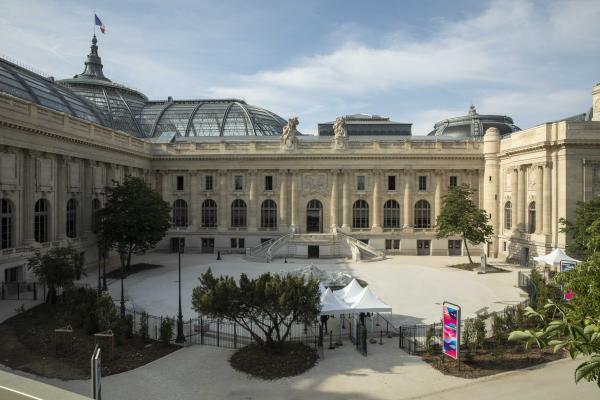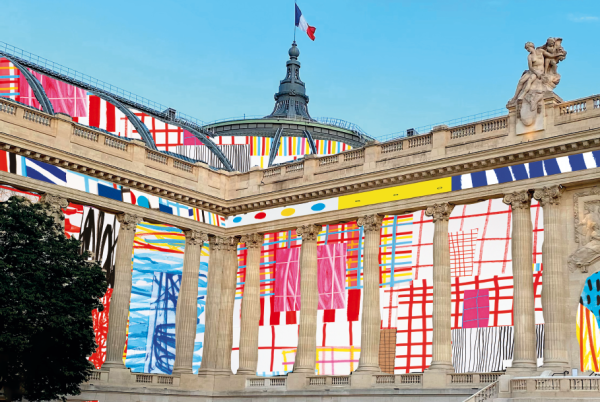Votre panier est vide
Besoin d'inspiration ?
Rendez-vous dans le programme en ligne du GrandPalais
Article -

Greek Antiquity
Origins: between coherency and diversity
Greek art often finds its inspiration in Aegean civilizations, for a long time known only through Homeric sagas (an oral tradition from the Second Millennium, written down in around 750 BC). The first artistic forms from Greek Antiquity appeared very early on. Stone figurines from the Cyclades (Neolithic) were followed by delicate frescoes and the precious arts of the palace at Knossos (Minoan civilization, from the name Minos, mythical king of Crete, 3500-1450 BC), then the powerful Cyclopean architecture (solid constructions from the Mycenaean period, 1600-1100 BC).
Although very widespread, the Greek world, which was grouped into colonies and then cities which sprang up around the Mediterranean, was united by a single koine (artistic language), which can be seen adapted down the centuries and throughout the regions. Four main stages in Greek art can be distinguished: the Geometric, Archaic, Classical and Hellenistic periods.
The Geometric Period
The Geometric Period (1050-680 BC) corresponds to an initial period of assimilation particularly inspired by the East. Mainly known for its ceramics, this period is also marked by the adoption of the Phoenician alphabet, bronze, gold and silver work and the establishment of a decorative range of ornaments and animals. But the Geometric style above all introduced the fundamental values of Greek art: symmetry and harmony of proportions.
The Archaic Period
However, it was only during the Archaic Period (680-483 BC), that the privileged forms of art developed that would for a long time structure all Greek production. It is in this period that representation of the human figure became codified: it is expressed by the famous model couple composed of the Kouros (naked man) and the Kore (clothed woman).
From the 8th century BC, shrines were almost the only place where art flourished. Entirely focussed on its religious function, Greek art is in fact deeply sacred: the architect, like the sculptor and the painter, always worked on votive works (temples, pediments, porticos, treasuries, monuments, alters, etc.). Restricted by the strict rules which governed iconography and the function of works, craftsmen demonstrated extraordinary ingenuity in constantly renewing forms and improving techniques. Aware of their creative work, many of them also signed their production and enjoyed a very respected position in society (craftsmen and bronze smiths were placed under the divine patronage of Athena and Hephaistos).
The Classical Period
Several great names survive from the Classical Period (483-338 BC) including: Phidias, Polykleitos and Praxiteles. A real golden age in Greek civilization, this period was characterized by the hegemony of Athens and the extraordinary growth in artistic production. Many works were undertaken under Pericles, the most famous of which related to the reconstruction of the Acropolis (sacked by the Persians in 480 BC).
In terms of form, two trends developed in parallel. Firstly, the search for perfect harmony led in particular to the establishment of the Polykleitos’s Kanon governing ideal proportions of the human body (corresponding to the subjects represented: gods, heroes and athletes). Secondly, the fondness for illusion and the confrontation of representation and reality can be seen in the very advanced practice of imitation (mimesis). This laid the foundations for a debate between idealism and realism, while the style of sculpture developed increasingly towards mannerism (technical properties of marble producing a completely new sensuality of the body).
The Hellenistic Period
The Hellenistic Period (338-31 BC continued along these lines and developed particularly expressive art: a fondness for movement; attention paid to the expression of emotion; fashion of wet drapery. At the same time, the Greek world underwent profound economic and political changes: the crisis of cities encouraged the emergence of new monarchies and the conquests of Alexander the Great over the Attalid kingdoms in Pergamum, the Seleucids in Antioch or the Lagids in Alexandria. These transformations ended up secularizing art by giving it new functions: pomp and decoration of palaces through painting and mosaics and the cult of leadership through portrait art.
After decline, universality
In 31 BC, the battle of Actium marked the fall of the Greek world and heralded the political and economic supremacy of Rome. However, even after the civilisation from which it arose, Greek art has never ceased to inspire artists since. From its immediate appropriation by the Romans up to the numerous returns to Classicism throughout the history of art, without forgetting the Italian Renaissance, the range of forms from Greek Antiquity has become a universal reference point for Western art.
Roman Antiquity
The influences of Roman art
While it is unfair and wrong to consider Roman art as a simple pale imitation of Greek art, it must be said that clear and stated bonds exist between the two Antique worlds. According to legend, it was Aeneus, son of Aphrodite and hero of the Trojan war, who, at the end of a long journey around the Mediterranean, moved into the Latium (12th century BC). One of his descendants, Romulus, founded Rome in 753 BC.
More historically, it was through trade, and then the political and military expansion of the empire around the Mediterranean, that the Roman identity was forged. However, Roman art was not simply limited to appropriation of Greek models, but also drew much of its inspiration from the history of its own country (pre-Roman era of Italic cities and the Etruscan kingdom), of which some marvellous examples survive: terracotta sarcophagi, gold and silver work, fresco paintings in tombs, etc.
Strictly speaking, Roman art developed in two main phases corresponding to two distinct political regimes: the Republic (509-31 BC) firstly, then the Empire (31 BC – AD 476 C).
Art under the Republic
Over the course of the Republic, the taste for Hellenistic art developed particularly as a result of the triumphal procession of spoils of war taken from conquered Greek cities. Attracted by Greek painters and sculptors, the Romans seized both physically and symbolically upon a rich and opulent heritage: the haul represented the appropriation of the enemy’s culture.
They also glorified their victories in cities by commissioning foreign craftsmen and artists (especially from Athens) to carry out entire architectural projects, groups of statuary and series of paintings in their honour (monument of Aemilius Paulus in Delphi). For generals, it was above all a question of setting a lasting mark of their military exploits in stone.
At the same time, private art (paintings, mosaics and sculptures), which could be produced either locally or far away, developed in aristocratic homes. It decorated the villas of rich families (Villa of the Papyruses in Herculaneum).
Art under the Empire
With the emergence of the Empire in 27 B C, art’s political role continued, in particular through heroic representations of the Emperor (Augustus of Prima Porta). However, the relative stability which followed the civil wars at the end of the Republic enabled the introduction of more peaceful themes (Ara Pacis). In Rome, the ongoing construction of the forum continued to provide the city with large monuments which structured public life: forum, theatre, amphitheatre, public baths, while other large urban centres developed according to the grid plan model.
In the first century, an initial period of unrest rippled through the Empire. At the same time, the tragic eruption of Vesuvius destroyed Pompeii and encased the whole city in just a few hours, thereby providing posterity with a completely unique archaeological site.
Later, under Hadrian’s reign, the Empire enjoyed a strong economy, conducive to a blossoming in art (Hadrian’s villa in Tivoli) before the Barbarian invasions of the 3rd century began to gradually weaken Rome’s power. During this period, the Imperial will was expressed above all through the architecture of Mediterranean cities, until the 4th century, when the Roman Empire was split in two (Eastern Roman Empire and Western Roman Empire) and its running entrusted to four emperors (called the Tetrarchy).
Very soon however, Constantine took back all power in the west to himself and introduced freedom of worship for the various religions. The triumph of Christianity eventually brought about the fall of the Roman Empire and produced a hybrid art, both profoundly Christian but also borrowing from Pagan culture (sarcophagi combining Greco-Roman mythology and Biblical references).
Votre panier est vide
Besoin d'inspiration ?
Rendez-vous dans le programme en ligne du GrandPalais
See content : Plan your family trip to the Grand Palais

Article -
This autumn, there's no need to choose between art, games and discovery: the Grand Palais brings it all together in one place. So get your curious, dreamy, playful selves ready... and set a course for a great family vacation in the heart of Paris! Here's a sneak preview of what's in store.
See content : New season, new exhibitions: tickets now on sale

Article -
Ticketing for our upcoming exhibitions is now open!
See content : What can families do at the Grand Palais right now?

Article -
This autumn, there's no need to choose between art, science and discovery: the Grand Palais brings them all together for you. So get your curious, your dreamers, your players ready... and discover the program for the coming weeks!